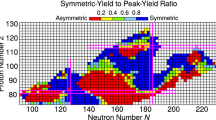Abstract
In this paper, the role of the mass distribution of fission fragments in the formation of heavy elements is considered. Two models of the mass distribution of fission fragments have been analyzed in detail: the Kodama–Takahashi model with a predominantly asymmetric distribution, and a model based on nuclear systematics with an almost symmetric distribution of fission remnants, which considers fission neutrons. It is shown that, in the merger scenario of a neutron star, the agreement between the second peak on the calculated abundance curve and observations can be obtained only if the distribution of fission remnants is symmetrical and fission neutrons are accounted for.



Similar content being viewed by others
REFERENCES
E. M. Burbridge et al., “Synthesis of the elements in stars,” Rev. Mod. Phys. 29, 547—650 (1957).
C. Sneden et al., “Evidence of multiple r-process sites in the early Galaxy: New observations of CS 2289220521,” Astrophys. J. Lett. 533, L139–L142 (2000).
F.-K. Thielemann et al., “Neutron star mergers and nucleosynthesis of heavy elements,” Annu. Rev. Nucl. Part. Sci. 67, 253–276 (2017).
N. R. Tanvir et al., “The emergence of a lanthanide-rich kilonova following the merger of two neutron stars,” Astrophys. J. Lett. 848, L27–L35 (2017).
D. Watson et al., “Identification of strontium in the merger of two neutron stars,” Nature 574, 497—506 (2019).
I. V. Panov, F.-K. Thielemann, and C. Freiburghouse, “Could fission provide the formation of chemical elements with A < 120 in metal-poor stars?,” Nucl. Phys. A 688, 587—589 (2001).
I. V. Panov and F.-K. Thielemann, “Final r-process yields and the influence of fission: The competition between neutron-induced and beta-delayed fission,” Nucl. Phys. A 718, 647—649 (2003).
I. V. Panov et al., “Neutron-induced astrophysical reaction rates for translead nuclei,” Astron. Astrophys. 513, A61 (2010).
T. Kodama and K. Takahashi, “R-process nucleosynthesis and nuclei far from the region of β-stability,” Nucl. Phys. A 239, 489—510 (1975).
M. G. Itkis, V. N. Okolovich, and G. N. Smirenkin, “Symmetric and asymmetric fission of nuclei lighter than radium,” Nucl. Phys. 502, 243—260 (1989).
I. V. Panov, I. Yu. Korneev, and F.-K. Thielemann, “The r-process in the region of transuranium elements and the contribution of fission products to the nucleosynthesis of nuclei with A ≤ 130,” Astron. Lett. 34, 189—197 (2008).
I. Yu. Korneev and I. V. Panov, “Contribution of fission to heavy-element nucleosynthesis in an astrophysical r-process,” Astron. Lett. 37, 864—873 (2011).
I. V. Panov and A. D. Dolgov, “Effect of spontaneous fission models on the production of cosmochronometer nuclei in the r-process,” JETP Lett. 98, 446—449 (2013).
K.-H. Schmidt and B. Jurado, “Global view on fission observables–new insights and new puzzles,” Phys. Proc. 31, 147—157 (2012).
A. Kelic et al., “Cross sections and fragment distributions from neutrino-induced fission on r-process nuclei,” Phys. Lett. B 616, 48—58 (2005).
S. Panebianco et al., “Role of deformed shell effects on the mass asymmetry in nuclear fission of mercury isotopes,” Phys. Rev. C 86, 064601 (2012).
B. D. Wilkins, E. P. Steinberg, and R. R. Chasman, “Scission-point model of nuclear fission based on deformed-shell effects,” Phys. Rev. C 14, 1832—1863 (1976).
O. Korobkin et al., “On the astrophysical robustness of the neutron star merger r-process,” Monthly Notices Royal Acad. Sci. 426, 1940—1949 (2012).
M. Eichler et al., “The role of fission in neutron star mergers and its impact on the r-process peaks,” Astrophys. J. 808, 30—42 (2015).
S. Goriely, “The fundamental role of fission during r‑process nucleosynthesis in neutron star mergers,” Eur. Phys. J. A 51, 22 (2015).
S. Goriely et al., “New fission fragment distributions and r-process origin of the rare-earth elements,” Phys. Rev. Lett. 111, 242502 (2013).
J.-F. Lemaître et al., “Fission fragment distributions and their impact on the r-process nucleosynthesis in neutron star mergers,” Phys. Rev. C 103, 025806 (2021).
I. V. Panov, “Mass distribution of fission fragments and abundances of heavy nuclei produced in the r-process,” Phys. At. Nucl. 84, 683—693 (2021).
C. Freiburghaus, S. Rosswog, and F.-K. Thielemann, “r-process in neutron star mergers,” Astrophys. J. 525, L121–L124 (1999).
J. M. Pearson, R. C. Nayak, and S. Goriely, “Nuclear mass formula with Bogolyubov-enhanced shell-quenching: Application to r-process,” Phys. Lett. B 387, 455—459 (1996).
P. Möller, B. Pfeiffer, and K.-L. Kratz, “New calculations of gross b-decay properties for astrophysical applications: Speeding-up the classical r process,” Phys. Rev. C 67, 055802 (2003).
I. V. Panov et al., “Influence of spontaneous fission rates on the yields of superheavy elements in the r-process,” Astron. Lett. 39, 150—160 (2013).
R. Vandenbosch and J. R. Huizeng, Nuclear Fission (Academic Press, New York, 1973).
ACKNOWLEDGMENTS
The authors thank F.-K. Thielemann and M. Eichler for helpful discussions of the physical processes affecting the formation of peaks on the heavy-nucleus abundance curve.
Funding
The work was supported by the Russian Science Foundation (project no. 21-12-00061).
Author information
Authors and Affiliations
Corresponding author
Ethics declarations
The author declares that he has no conflicts of interest.
Additional information
Translated by G. Dedkov
Rights and permissions
About this article
Cite this article
Panov, I.V. Fission-Fragment Mass Distribution and Heavy Nuclei Nucleosynthesis. Phys. Part. Nuclei 54, 542–546 (2023). https://doi.org/10.1134/S1063779623030267
Received:
Revised:
Accepted:
Published:
Issue Date:
DOI: https://doi.org/10.1134/S1063779623030267




